Physical Address
304 North Cardinal St.
Dorchester Center, MA 02124
Physical Address
304 North Cardinal St.
Dorchester Center, MA 02124
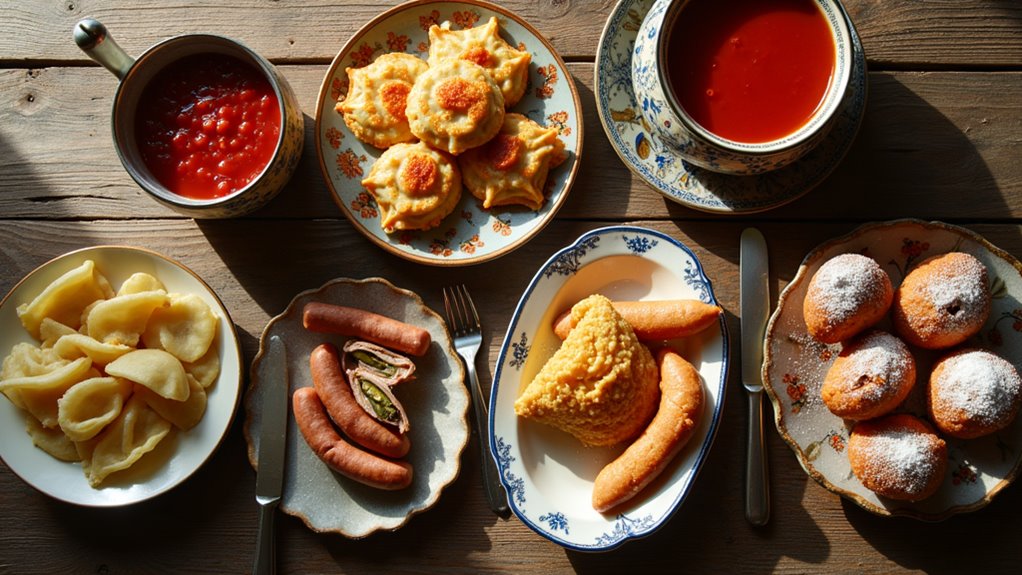
Indulge in Poland's hearty cuisine through 9 must-try dishes that transform simple ingredients into unforgettable cultural treasures.
Polish cuisine offers hearty comfort foods that showcase centuries of tradition and flavor. You’ll discover soul-warming żurek (sour rye soup), versatile pierogi dumplings, and the iconic hunter’s stew bigos. Don’t miss kotlet schabowy (pork cutlet), gołąbki (stuffed cabbage rolls), Sunday rosół (chicken soup), smoked oscypek cheese, and sweet makowiec rolls. These dishes tell Poland’s cultural story through simple ingredients transformed into unforgettable meals. Each bite reveals more about this opulent culinary heritage.
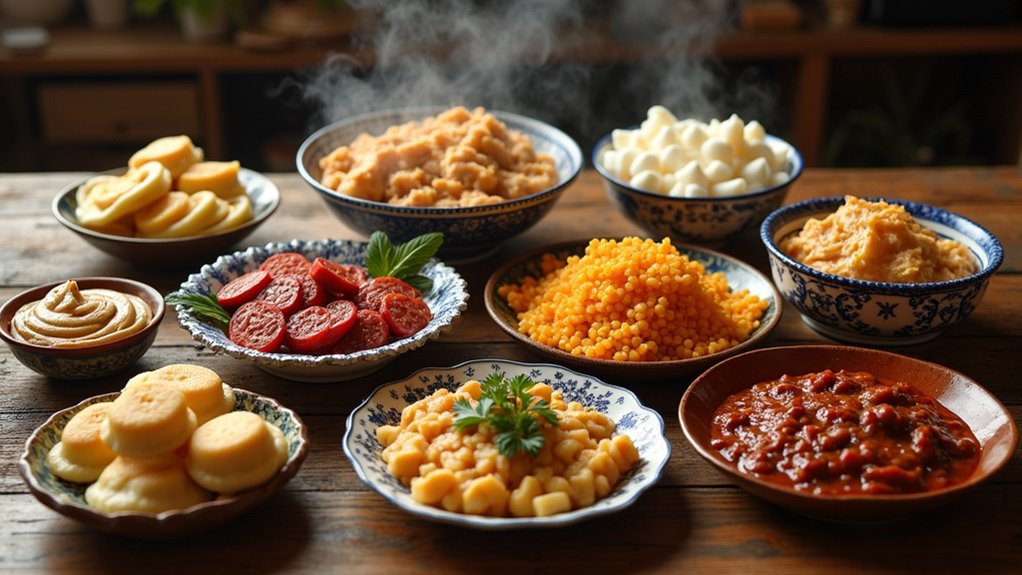
Why is Polish cuisine one of Europe’s most underrated culinary treasures? It’s the perfect blend of hearty comfort food developed over centuries when resources were limited and meals needed to sustain through harsh winters.
Polish cuisine remains Europe’s hidden gem, offering centuries-old comfort food perfected through necessity and tradition.
When you visit Poland, you’ll want to try pierogi, the stuffed dumplings that come with various fillings from savory meat to sweet fruit. Don’t miss bigos, a hunter’s stew that combines sauerkraut, meats, and pickled fruits for a complex flavor profile. Many traditional Polish dishes require long preparation times, reflecting the cultural importance and celebratory nature of food in Polish society.
Kotlet schabowy, Poland’s answer to schnitzel, offers a crispy breaded pork cutlet that’s irresistible. For soup lovers, both red beetroot barszcz and mushroom zupa grzybowa showcase Poland’s foraging traditions. After enjoying these hearty meals, you might consider exploring coastal activities in regions like Dubrovnik for a refreshing contrast to Poland’s robust cuisine.
Round out your culinary adventure with kiełbasa, gołąbki, rosół, and pączki for dessert.
You’ll find this hearty soup packed with white and smoked sausages, bacon, potatoes, and aromatic spices like marjoram and garlic.
Traditionally served during Easter celebrations in a hollowed-out bread bowl with boiled eggs, Żurek marks the end of Lenten fasting.
Each Polish region offers its own variation, but they all deliver that satisfying combination of smoky, tangy flavors. The key ingredient that gives this soup its distinctive sour taste is the żur starter, made by fermenting rye flour with water for several days.
Polish cuisine features this iconic soup as one of its most beloved traditional dishes.
Pair it with a slice of rye bread and a cold beer for an authentic experience that’ll transport you straight to a Polish family gathering.

While żurek warms Polish souls with tangy comfort, another national treasure awaits on virtually every Polish table. Pierogi ruskie—half-moon dumplings stuffed with potatoes and farmer’s cheese—have become synonymous with Polish cuisine despite their Ruthenian origins (not Russian, as the name might suggest).
You’ll find these pillowy pockets boiled then often pan-fried for a delightful crispy edge. The name “ruskie” derives from East Slavic ethnic roots rather than modern Russia. The simple dough of flour, eggs, and water wraps around a savory filling that’s sometimes enhanced with fried onions or butter. Much like must-visit destinations, these dumplings are essential experiences for anyone exploring Polish culture.
Served with dollops of sour cream and crispy bacon bits, they’re fixtures at Christmas celebrations and family gatherings throughout Poland. Though traditional recipes remain sacred, you’ll now encounter everything from vegan versions to gourmet interpretations with truffle oil in Poland’s evolving culinary scene.
Among Poland’s most iconic dishes, bigos exemplifies the country’s plentiful culinary heritage and resourcefulness. This hearty stew combines sauerkraut, fresh cabbage, and various meats including pork, beef, and kielbasa, all slow-cooked to perfection with mushrooms and aromatic spices. Traditional preparation involves baking for hours until the meat becomes exceptionally tender and flavors fully develop.
A traditional Polish masterpiece where sauerkraut, fresh cabbage, and assorted meats meld in aromatic harmony.
You’ll find bigos at virtually every Polish celebration, especially during winter months when its warming properties are most appreciated. The flavors deepen each time it’s reheated, making it even more delicious the next day. Unlike the Mediterranean cuisine found in Greece or Turkey, Polish food tends to be heartier and more suited to colder climates.
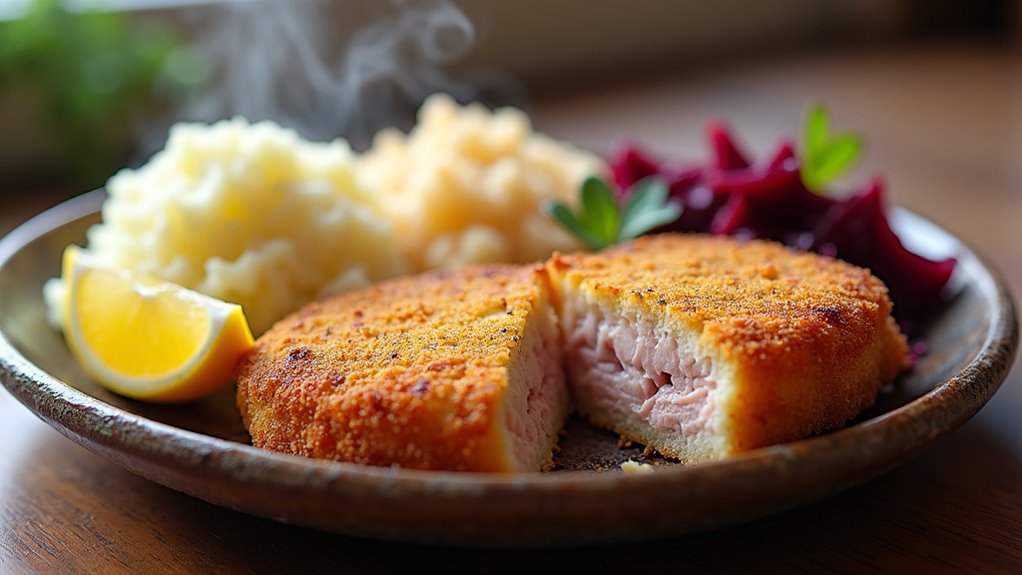
The kotlet schabowy stands proudly as Poland’s beloved answer to the Viennese schnitzel. This 19th-century adaptation features thinly pounded pork loin coated in the classic trio of flour, egg, and breadcrumbs before being fried to golden perfection in lard or oil.
You’ll find this comfort food at the heart of Polish family gatherings, typically served with boiled potatoes and mizeria (cucumber-dill salad). While many travelers explore Poland’s cuisine, some also notice the contrast with other countries like Turkey where stray dogs roam freely rather than pets enjoying table scraps at family meals.
The dish gained nationwide popularity during post-WWII rationing, cementing its status as a cultural icon. First appearing in Ćwierczakiewiczowa’s cookbook from 1860, it gradually became a staple in Polish homes.
What distinguishes kotlet schabowy is its pork-centric approach—a reflection of Poland’s culinary traditions. When you’re enjoying this crispy delight, you’re participating in generations of home cooking technique passed down through Polish kitchens.
Lovingly wrapped like little packages, gołąbki represent the essence of Polish comfort food at its finest. These cabbage rolls (pronounced guh-WOOMP-key) combine ground meat, rice, and onions swaddled in tender cabbage leaves, then baked in a tangy tomato sauce. The name itself comes from the Polish word “golab” meaning pigeon, as the finished rolls resemble a pigeon’s chest. While enjoying this hearty dish, you might be reminded of the Nordic cuisines which similarly embrace comforting, simple ingredients prepared with care.
You’ll find them at nearly every Polish family gathering, where they’re served alongside fresh rye bread perfect for soaking up the flavorful sauce.
Making gołąbki at home is surprisingly budget-friendly:
Leftovers freeze beautifully, making gołąbki an ideal make-ahead meal for busy weeknights!
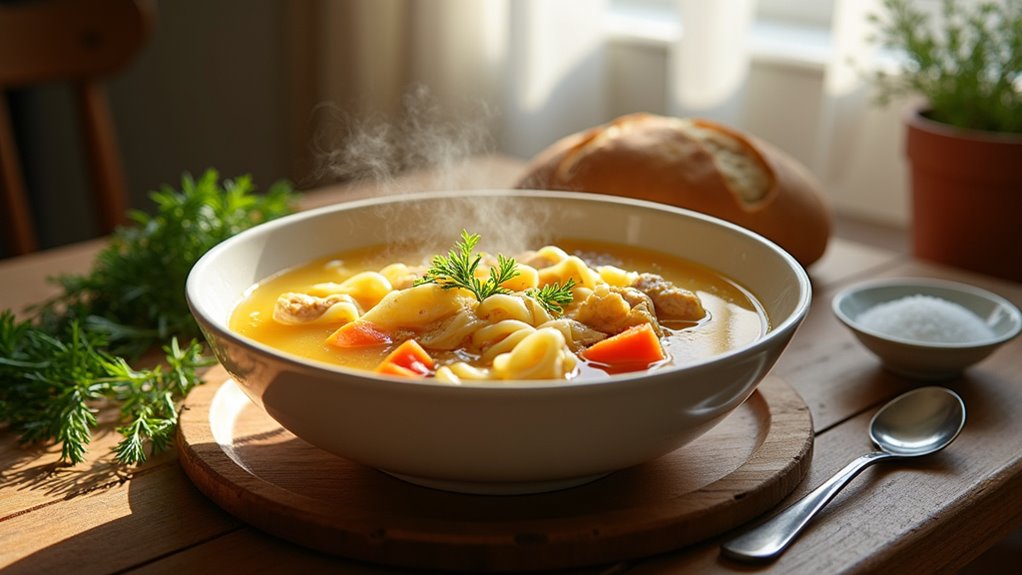
Simmering away in Polish kitchens every Sunday morning, rosół functions as the nation’s most beloved soup ritual. You’ll find this clear, golden broth at family gatherings, weddings, and christenings—or whenever someone feels under the weather. Poles believe in its healing powers!
The magic happens when chicken (sometimes with beef bones), carrots, parsnips, leeks, and aromatic spices slowly cook together. The key to perfect rosół? Skimming impurities to maintain that signature clarity. Traditionally, onion skins are charred directly on stove burners to enhance both flavor and color. Unlike tourist destinations in Croatia, enjoying a bowl of rosół in Poland remains an affordable culinary pleasure.
Serve it piping hot with egg noodles or vermicelli, garnished with fresh parsley. Each region adds its own twist—some include dried mushrooms or tomato passata. Beyond its comforting taste, rosół delivers protein, vitamins, and collagen—making it both delicious and nutritious.
Hidden among Poland’s majestic Tatra Mountains, oscypek serves as a treasure of Polish culinary heritage that you’ll rarely find outside its mountainous homeland. This spindle-shaped cheese is crafted from sheep’s milk by specialized shepherds called “bacas” during the milking season from April to October. The traditional process involves pressing the cheese into decorative wooden forms before smoking and final aging. While Finland is known for its high cost of living, Poland offers more affordable culinary experiences like sampling authentic oscypek.
What makes this cheese special:
You’ll commonly find oscypek grilled before serving, enhancing its salty, smoky flavor profile.
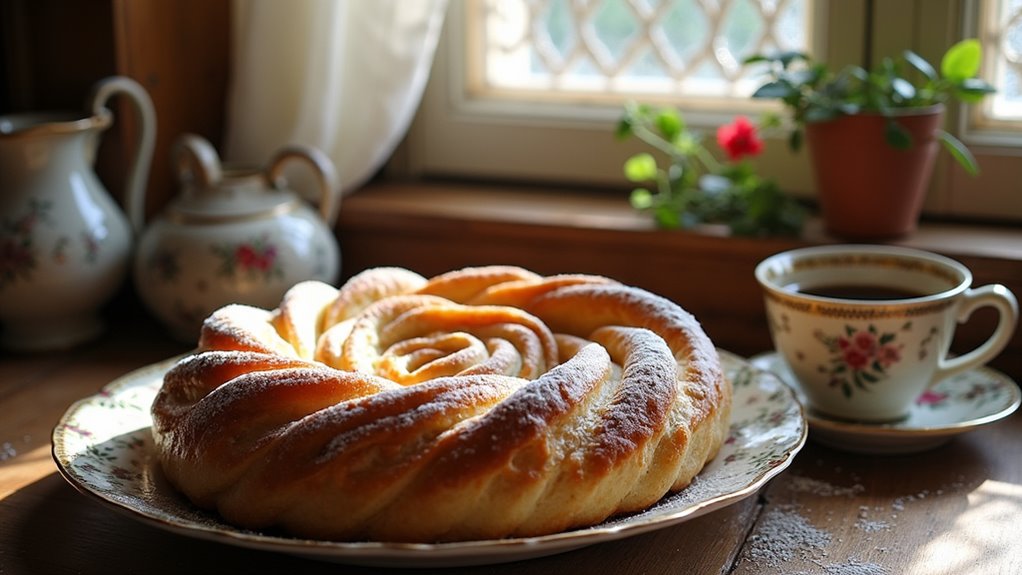
Step into the aromatic world of makowiec, Poland’s beloved sweet bread that wraps soft yeast dough around a luscious poppy seed filling. This traditional pastry has graced Polish holiday tables for centuries, becoming an essential part of Christmas and Easter celebrations.
You’ll find makowiec’s opulent filling made from ground poppy seeds mixed with honey, sugar, and sometimes raisins or nuts. The yeast dough requires patience as it rises before being rolled around this sweet mixture and baked to golden perfection. Visiting bakeries in Szczecin, Poland, you’ll see shelves lined with these delightful rolls alongside other traditional Polish pastries.
More than just a dessert, makowiec represents Polish heritage and family tradition. It’s commonly enjoyed during afternoon tea or as a sweet second breakfast. While traditionally high in calories, you can find lighter variations that maintain the authentic flavor. This iconic Polish treat has become a must-visit attraction for culinary travelers seeking authentic European pastry experiences.
Don’t miss this iconic treat when exploring Polish cuisine!
Polish cuisine is your gateway to a nation’s heart and history. As you’ve journeyed through these nine dishes, you’ve tasted centuries of tradition on every spoon and fork. Don’t just visit Poland—taste it! Whether it’s the smoky embrace of oscypek or the comforting hug of a perfectly formed pierogi, these flavors will dance on your palate long after you’ve returned home.